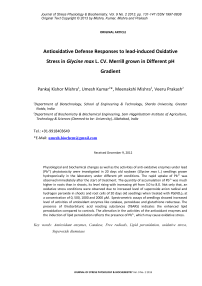Antioxidative defense responses to lead-induced oxidative stress in Glycine max L. cv. Merrill grown in different ph gradient
Автор: Mishra Pankaj Kishor, Kumar Umesh, Mishra Meenakshi, Prakash Veeru
Журнал: Журнал стресс-физиологии и биохимии @jspb
Статья в выпуске: 2 т.9, 2013 года.
Бесплатный доступ
Physiological and biochemical changes as well as the activities of anti-oxidative enzymes under lead (Pb 2+) phytotoxicity were investigated in 20 days old soybean ( Glycine max L.) seedlings grown hydroponically in the laboratory under different pH conditions. The rapid uptake of Pb 2+ was observed immediately after the start of treatment. The quantity of accumulation of Pb 2+ was much higher in roots than in shoots, its level rising with increasing pH from 3.0 to 8.0. Not only that, an oxidative stress conditions were observed due to increased level of superoxide anion radical and hydrogen peroxide in shoots and root cells of 20 days old seedlings when treated with Pb(NO 3) 2 at a concentration of 0, 500, 1000 and 2000 μM. Spectrometric assays of seedlings showed increased level of activities of antioxidant enzymes like catalase, peroxidase and glutathione reductase. The presence of thiobarbituric acid reacting substances (TBARS) indicates the enhanced lipid peroxidation compared to controls. The alteration in the activities of the antioxidant enzymes and the induction of lipid peroxidation reflects the presence of Pb 2+, which may cause oxidative stress.
Antioxidant enzymes, catalase, free radicals, lipid peroxidation, oxidative stress, superoxide dismutase
Короткий адрес: https://sciup.org/14323730
IDR: 14323730
Текст научной статьи Antioxidative defense responses to lead-induced oxidative stress in Glycine max L. cv. Merrill grown in different ph gradient
Superoxide dismutase
Lead (Pb2+), a heavy metal, is a potent environmental pollutant (Sharma and Dubey, 2005) and lead pollution of the environment is synonymous with civilization. Pb2+ contamination has reported from mining, smelting activities, Pb-containing paints, gasoline, explosives, as well as from the disposal of municipal sewage sludge (Levine et al., 1989). Although it is not essential for plants; it is absorbed and accumulated in different plant tissues (Kabata-Pendias and Pendias, 1999) with the highest amount in the root tissues (Verma and Dubey, 2003). It can cause multiple direct and indirect effects on plant’s physiological and biochemical activities like growth and metabolism, membrane disorganization and reduced photosynthesis (Ahmad et al., 2008) along with visible symptoms including stunted growth and small leaves. It is generally accepted that toxic levels of heavy metal can affect a variety of physiological processes in plants. Sauve et al. (1997) found that the equilibrium between metal spatial pattern, solubility, adsorption and exchange on solid phase sites is intimately connected to solution pH. Hence, soil pH affects metal speciation, solubility, complexation and adsorption of metal ions (Reddy et al., 1995). Similarly, numerous studies have fond that soil pH have a large effect on metal bioavailability (Mesquita et al., 2002).
One of the major consequences is the production of large quantities of reactive oxygen species (ROS), react with lipids, proteins, pigments, and nucleic acids and cause lipid peroxidation, membrane damage, and inactivation of enzymes, thus affecting cell viability (Schutzendubel and Polle, 2002). The deleterious effects resulting from the cellular oxidative state may be alleviated by enzymatic and nonenzymatic antioxidant machinery of the plant that vary at various cellular and subcellular levels in different plants. Plants use a diverse array of enzymes as well as low molecular weight antioxidants to scavenge different types of reactive ROS, thereby protecting potential cell injury against tissue dysfunction (Halliwell, 1987). SOD is a key enzyme in protecting cells against oxidative stress and dismutates superoxide radical (O 2 ˙-) to H 2 O 2 and oxygen (Alscher et al ., 2002).
However, hydrogen peroxide is also toxic to cells and has to be further detoxified by catalase and peroxidases to water and oxygen.
Glycine max belongs to family fabaceae is a fast growing plant which produces a high biomass even in heavy metal polluted soils. Thus this plant might be a potential candidate for phytofiltration and /or phytostabilization of heavy metal contaminated waste waters. So far this plant species has been used in studies of the effects of heavy metals like (De Oliveira et al ., 1994) stress on plants. Hence the present study was aimed to understand the effects of lead toxicity on metabolic homeostasis and changes of SOD, GPOD, CAT and GR activity of in vitro cultured Glycine max seedlings treated with different concentration of Pb2+ to better understand the defensive mechanisms under different pH levels.
MATERIALS AND METHODS
Plant material and growth conditions
Seeds of Glycine max L. cv. Merrill (family: Fabaceae) were sterilized with 1% NaClO for 5 min, then washed twice with distilled water and germinated in the dark in petri dishes. Four-days old seedlings were grown hydroponically on 1/4 strength modified Hoagland nutrient solution (Pickering et al ., 2000). Seedlings were grown at 24˚C, with a light intensity of 300 μMm-2s-1 and a 14h photoperiod. After growing for 10 days (appearance of four true leaves), they were treated with 0, 500, 1000 and 2000 μM Pb2+ as Pb(NO 3 ) 2 for 5 days continuously. The pH was adjusted 3.0, 6.0 and 8.0 for both culture and treatment solution and renewed everyday to avoid fungal infection. The shoots and roots of 20 days old seedlings were collected and washed in 10 mM CaCl 2 to remove Pb2+ accumulated on their surface and stored in an -80˚C freezer for further experiments.
Determination of production rate of superoxide anion radical (O2.-)
Shoots and roots were taken in a test tube and mixed with the 10 ml of solution containing 0.05 M phosphate buffer solution (PBS) maintained at pH 7.8, 0.05% nitroblue tetrazolium (NBT), and 10 mM NaN 3. After 5 min incubation in the dark, 2 ml of the solution was taken up from the tubes and heated at 85˚C for 15 min. Then, the samples were cooled and absorbance was measured at 580 nm (Doke, 1983).
Determination of production rate of H2O2
The content of H 2 O 2 was measured according to the modified method of Patterson (1984). Harvested tissues preserved in freezer were ground in 6 ml of ice-cold acetone. The homogenate was centrifuged at 8,000 g at 4°C for 30 min. The supernatant was collected and out of which only 0.5 ml of supernatant was mixed with 1.5 ml mixture of CHCl 3 and CCl 4 (1:3, v/v). Then, 2.5 ml of distilled water was added to the solution to make the volume 4.5 ml. The mixture was centrifuged at 1,000 g for 1 min, and the water phase was collected for H 2 O 2 determination. To set control, 0.1 ml of CAT (0.3 unit) was added to the 1 ml of subsequent supernatant to remove the H 2 O 2 .
For the treatments, CAT solution was replaced by 0.1 ml MQ water (QTUM 0001 X; Millipore Co.). The mixtures were incubated at 37°C for 10 min. The sample treatments as well as the control were mixed with 1 ml of PBS (0.2 M, pH 7.8) and 1 ml of 4-(2-pyridylazo) resorcinol (200 mM) solution. The reaction mixtures were incubated at 45°C for 20 min, and the absorbance was read at 508 nm.
Determination of lipid peroxidation
Lipid peroxidation was measured as described by Hedges et al. (1999) Approximately 0.5 gram plant tissues was homogenized in 80% ethanol and centrifuged at 3000 × g. Afterwards, the extract obtained was analyzed in two steps. At the first step, 1 volume of 20% (w/v) trichloroacetic acid (TCA) and 1 volume of 0.01% BHT (buthylated hydroxytoluene) were added to 1 volume of supernatant. At the second step, 1 volume of 20% TCA (contained 1 volume of 0.65% (2-thiobarbituric acid) TBA and 1 volume 0.01% BHT) were added to 1 volume extract taken from the supernatant. After vortexing both of the two samples for 10 sec, they were incubated in a hot water bath adjusted to 95oC for 25 min followed immediately by a shock treatment in an ice bath. The cooled samples were centrifuged at 3000g and absorbance values of samples were measured in spectrophotometer. First step samples were measured at 532 and 600 nm, whereas second samples at 440, 532 and 600 nm.
Results were obtained using the following formulas
[(Ab 532 + TBA) – (Ab 600 + TBA) – (Ab 532 - TBA) – (Ab 600 - TBA)] = A
[(Ab440+ TBA – Ab600 + TBA) ×0.0571] = B nmol MDA/ml = (A-B/157000) × 106
[Ab=absorbance]
[MDA = malondialdehyde]
Assays of antioxidative enzymes
Preparation of enzyme aliquot
Approximately 0.5 gram preserved samples were homogenized in 8 ml of solution containing 50 mM PBS (pH 7.6) and 0.1 mM Na-EDTA and then centrifuged for 15 min at 20,000 × g at 4°C.
Ascorbate peroxidase (APX)
Activity of APX was measured according to Cakmak (1994) by monitoring the rate of H 2 O 2 -dependent oxidation of ascorbic acid (AsA) at 290
nm. A reaction mixture (1 ml) was prepared containing 0.1 ml of 50 mM of PBS (pH 7.6), 0.1 ml of 0.1 mM EDTA, 0.1 ml of 12 mM H 2 O 2 , 0.1 ml of 0.25 mM AsA and 0.6 ml of enzyme aliquot.
Guaiacol peroxidase (GPOD)
Activity of GPOD was measured according to Hammerschmidt et al . (1982). To assay the activity of GPOD 3.0 ml of guaiacol solution, 3.0 ml of PBS, 0.4 ml of enzyme aliquot and 0.1 ml H 2 O 2 solution was added and assayed spectrophotometrically at 436 nm. The time required to show the difference in reading due to oxidation of guaiacol was recorded.
Catalase (CAT)
Activity of catalase (CAT) was measured as described by Cakmak and Marschner (1992). The assay was based on the degradation of H 2 O 2 at 240 nm. The reaction mixture (1.0 ml) was prepared by adding 0.1 ml of 50 mM PBS (pH 7.6), 0.1 ml of 0.1 mM EDTA, 0.1 ml of 100 mM H 2 O 2 and 0.7 ml of enzyme aliquot. The degradation of H 2 O 2 was monitored at 240 nm.
Superoxide dismutase (SOD)
For the assay of SOD, 5.0 ml of reaction mixture was prepared in glass vials by adding the constituents in the following order; 50 mM phosphate buffer (pH 7.6), 0.1 mM Na-EDTA, enzyme aliquots (50-150 μM), 50 mM Na 2 CO 3 (pH 10.2), 12 mM L-methionine, 75 μM NBT and at last 2 μM riboflavin was added. The glass vials were kept under a light intensity of about 400 μM m-2 s-1 in normal room temperature to carry out the reaction. One unit of SOD activity was defined as the amount of enzyme required to cause 50% inhibition of the rate of NBT reduction measured at 560 nm (Cakmak and Marschner, 1992).
Glutathione reductase (GR)
The activity of Glutathione reductase (GR) was assayed using the method as described by Cakmak and Marschner, (1992) and Cakmak (1994). The reaction mixture (1.0 ml) was prepared by adding 0.1 ml of 50 mM PBS (pH 7.6), 0.1 ml of 0.1 mM EDTA, 0.1 ml of 0.5 mM GSSG, 0.1 ml of 0.12 mM NADPH and 0.6 ml of enzyme aliquot. The reaction mixture showed the decrease in absorbance at 340 nm due to NADPH oxidation.
Measurement of lead accumulation
Roots and shoots of treated seedlings were thoroughly rinsed with deionized water and blotted dry. Samples were dried at 70°C in a forced-air oven, weight, and digested with 1:1 nitric to perchloric acid. Lead was determined by atomic absorption spectrometry (Yang et al ., 2001).
Statistical Analysis
Each result shown in tables was the mean of five replicated treatments. The significance of differences (p<0.05) between treatments and pH levels was statistically evaluated by standard deviation and three way classification of “Analysis of Variance” technique were based on the appropriate F-tests.
RESULTS
Effect of Pb2+ on ROS accumulation
It is well known that ROS accumulation due to heavy metal absorption cause damages on organism. At pH 3.0 in shoot cells of G. max, the radical produced two fold at 1000 μM and four fold at 2000 μM concentration (Fig. 1) with the recorded values 32.651 and 68.342 mol min-1 per mg protein fresh weight (FW) with the respect of 500 μM. In root cells of G. max the pH difference possesses similar impact on radical production rate at all metal concentrations at pH 8.0. The O2.- production levels in root cells at pH 8.0 were observed 38.644, 88.776, 170.452 mol min-1 per mg protein FW at 500, 1000 and 2000 μM concentration respectively (Table 1).
H 2 O 2 was measured to determine whether application of excessive Pb2+ caused oxidative stress in shoots and roots of G . max . In metal concentrations and pH dependent manner experiment, the H 2 O 2 content increased markedly in the 2000 μM exposure and this stimulation reached a peak on 8.0 pH. The changes in H 2 O 2 levels were examined during the course of study and observed that application of Pb2+ at 500 to 2000 μM significantly increased the production of H 2 O 2 compared with over control in shoot and root cells (Table 1, Fig. 2). These results suggested a close relation between the reduced glutathione (GSH) and H 2 O 2 content in G . max. However, the production of H 2 O 2 may not have toxic effect, but acts as a positive signal for the hyperaccumulation of Pb2+.
Effect of Pb2+ on lipid peroxidation
Lipid peroxidation is a free radical mediated process. The level of lipid peroxidaion was measured in terms of MDA (malondialdehyde) concentration. The striking increase in lipid peroxidation in Pb(NO 3 ) 2 treated seedlings of G . max demonstrated in shoot and root cells at various pH levels. The observed value at pH 8.0 and 2000 μM concentration was 109.193 nmol g-1 FW in shoot cells of G . max with three fold increase (Table 2). The similar trends were followed in the root cells of experimental seedlings. The levels of lipid peroxidation were slightly influenced by pH for 2000 μM in root cells as reported the percent value 147.22%, 171.63% and 166.72% at pH 3.0, 6.0 and 8.0 (Fig. 3).
Antioxidant enzymes
A crucial function of antioxidative enzymes is to remove excess reactive oxygen species (ROS), which can be toxic to plant cells. In the present study the effect of Pb2+ stress on specific activity of antioxidant enzyme APX in shoot and root cells of G . max at pH 3.0, 6.0 and 8.0 is depicted in Table 2. The increases in specific activity of APX in shoot and root cells also measured in percent numeric. Activity of APX at pH 8.0 was recorded 41.22%, 96.70% and 124.90% to 500, 1000 and 2000 μM respectively as compared to control (Fig. 4). In root cells of seedlings it was followed at same aspect but in remarkable concern than shoot cells.
Table 3 shows the increased activity of GPOD and CAT under Pb2+ stress condition in all different pH concentration. Heavy metal treated plants showed statistically significant increase activity of GPOD compared with control. At 2000 μM highest value of GPOD activity recorded in shoot cells , with the mean values 238.057, 295.143 and 341.413 unit mg-1 protein FW at pH 3.0, 6.0 and 8.0 respectively. Plants exposed to Pb2+ in the nutrient solution showed significantly higher GPOD activity in root cells with all given pH as compared over control (Fig. 5). Similarly, the over expression of CAT activity in shoot cells of hydroponically grown seedlings at various pH was recorded. With the concentration rises, a progressive increase in CAT activity was observed. CAT activity in shoot cells of G. max was increased two fold at 2000 μM Pb2+ at pH 8.0 over control (Fig. 6) which was comparatively lower than the activity observed in root at same concentration of Pb2+. Similar trend was observed with all experimental H+ concentrations and the highest activity of enzyme in both shoot and root cells was observed at 2000 μM Pb2+ concentration and at pH 8.0.
The maximum activity of SOD was recorded at highest concentration of Pb2+ at pH 8.0. As compared to control (Fig. 7), a significant percent increment of SOD activity in shoot cells was recorded by gradually increasing concentration of metals but not in dose dependent manner. In root cells of soybean the activity of SOD measured at 500, 1000 and 2000 μM were 101.342, 167.101, 199.030 unit mg-1 protein FW at pH 3.0; 108.143, 178.340, 212.143 unit mg-1 protein FW at pH 6.0 and 112.056, 213.346, 273.941 unit mg-1 protein FW at pH 8.0 (Table 4).
Applied Pb2+ have positive correlation with specific activity of GR in shoots and roots of treated plant seedlings with consideration of pH values. The maximum activity was found at 2000 μM concentration of metal; its level rose from 3.0 to 8.0 pH in shoot cells (Table 4). Similar patterns for root cells have been observed. The percent values in shoot cells compared to control at pH 3.0, 6.0, 8.0 were estimated 73.00%, 82.25% and 105.75% at
2000 μM concentration (Fig. 8). This indicated a non-specific effect of pH on ascorbate glutathione cycle. The results are all consistent with the role of ROS in the resistance response and the control of their levels to minimize toxic effects.
Lead accumulation in shoot and root cells
Table 5 showed the effect of pH on Pb2+ accumulation in shoots and root cells of G . max . Metal accumulation was significantly increased under rising pH levels range from 3.0 to 8.0 as well as with the metal supply. The mean values recorded at 500 μM were 42.514, 78.341 and 121.459 mg kg-1 (dry weight) DW at pH 3.0, 6.0 and 8.0 respectively in shoots and this trend was also followed in root cells but with higher content at each treatment compared to shoots. The accumulation rates of Pb2+ in root cells were remarkably enhanced 1271.90%, 1581.00% and 2255.25% as compared to control at pH 8.0 concentration 500 μM, 1000 μM and 2000 μM respectively (Fig. 9).
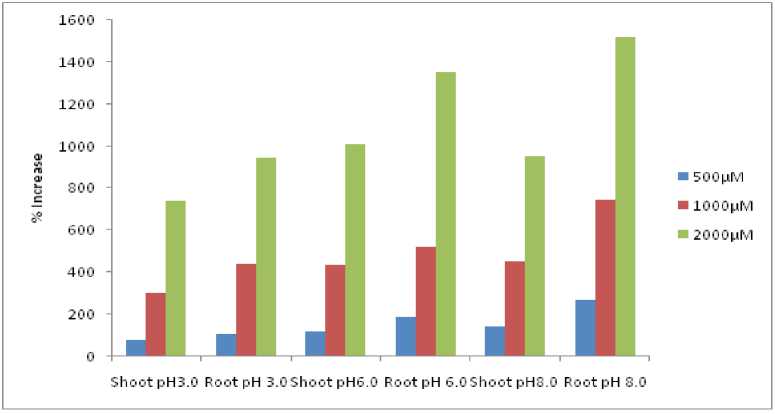
Figure 1: Generation of superoxide anion radical (O 2 .-) in Glycine max exposed to various concentrations (μM) of Pb2+ and at different pH.
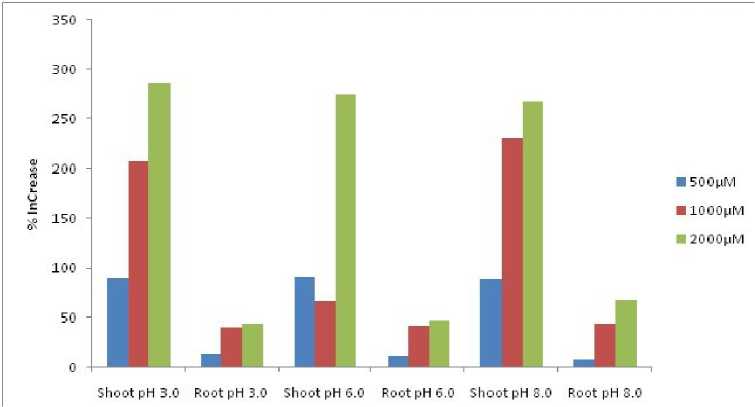
Figure 2: Endogenous levels of hydrogen peroxide (H 2 O 2 ) of Glycine max exposed to various concentrations (μM) of Pb2+ and at different pH.
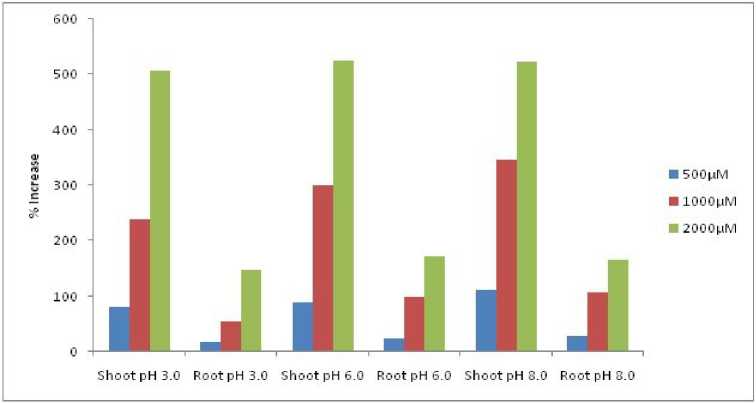
Figure 3: % increment of Lipid peroxidation (LP) in Glycine max at different pH and various concentrations (μM) of Pb2+.
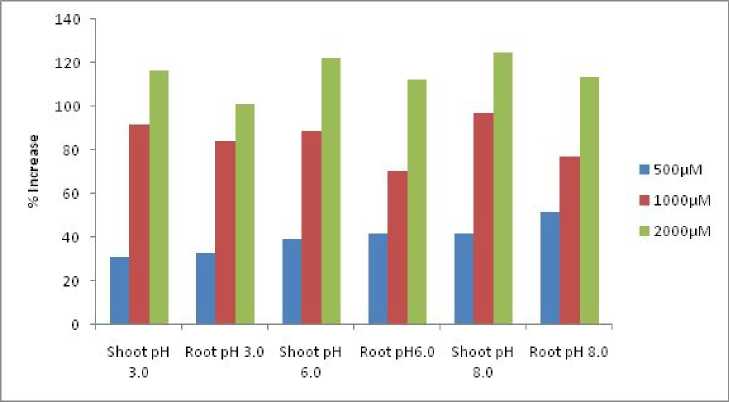
Figure 4: Ascorbate peroxidase (APX) activity of Glycine max to various concentrations (μM) of Pb2+ and at different pH.
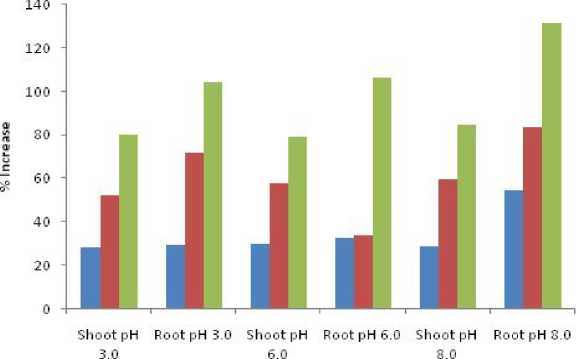
Figure 5: Guaiacol peroxidase (GPOD) activity in Glycine max at different pH and various concentrations (μM) of Pb2+.
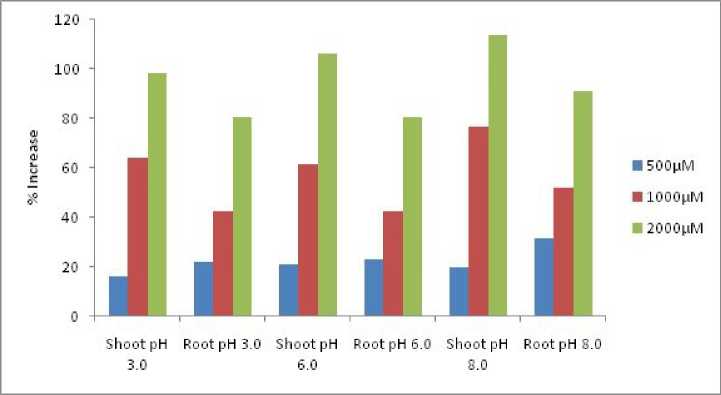
Figure 6: % increment of Catalase (CAT) activity of Glycine max at different concentrations (μM) of Pb2+ and various pH.
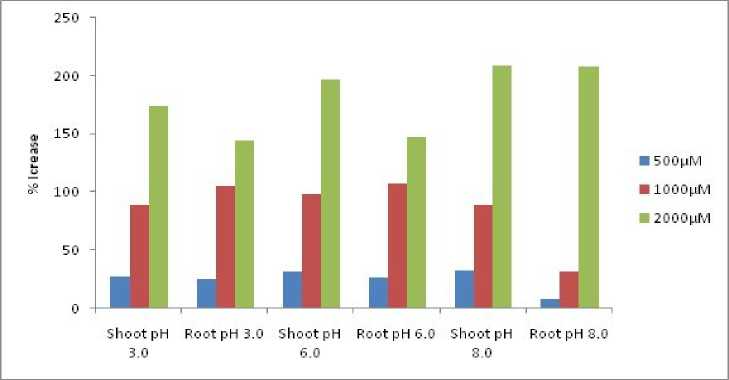
Figure 7: Superoxide dismutase (SOD) activity of Glycine max exposed to various concentrations (μM) of Pb2+ and at different pH.
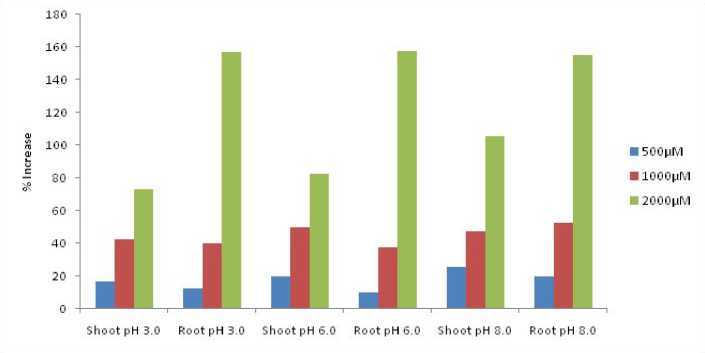
Figure 8: Glutathione reductase (GR) activity of Glycine max to various concentrations (μM) of Pb2+ and at different pH.
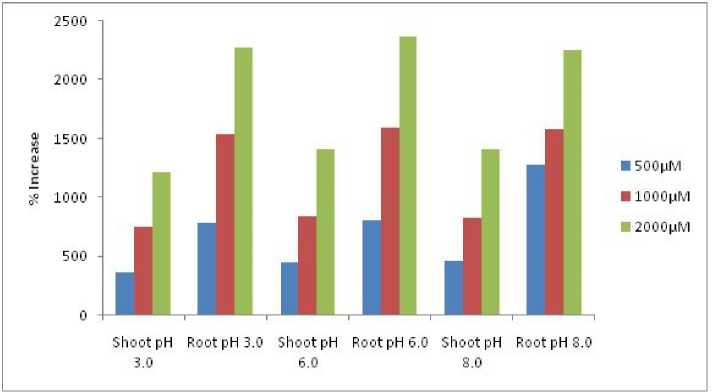
Figure 9: Accumulation of lead (mg kg-1) in Glycine max at different pH.
Table 1 . Endogenous levels of superoxide anion radicals (O 2 .-) and hydrogen peroxide (H 2 O 2 ) of Glycine max exposed to various concentrations of Pb2+.
|
Treatments (μM) |
O2.-(Mmin-1 mg-1 protein) |
H2O2 (μM g-1) |
||||
|
In shoots |
pH 3.0 |
pH 6.0 |
pH 8.0 |
pH 3.0 |
pH 6.0 |
pH 8.0 |
|
Control |
8.114±0.35 |
11.250±0.70 |
16.549±1.03 |
0.143±0.01 |
0.151±0.01 |
0.158±0.01 |
|
500 |
14.520±2.56 |
25.031±1.64 |
40.542±1.57 |
0.272±0.03 |
0.289±0.02 |
0.299±0.03 |
|
Pb2+ 1000 |
32.651±3.94 |
60.213±4.05 |
91.421±3.75 |
0.439±0.04 |
0.497±0.03 |
0.523±0.04 |
|
2000 |
68.342±4.21 |
124.563±4.05 |
168.056±3.96 |
0.552±0.04 |
0.566±0.52 |
0.580±0.04 |
|
In roots |
||||||
|
Control |
7.115±0.25 |
9.512±0.34 |
10.532±0.75 |
0.124±0.01 |
0.128±0.01 |
0.132±0.02 |
|
500 |
14.791±0.94 |
27.524±1.49 |
38.644±2.01 |
0.142±0.03 |
0.144±0.02 |
0.143±0.03 |
|
Pb2+ 1000 |
38.420±2.01 |
59.234±2.96 |
88.776±4.95 |
0.175±0.05 |
0.182±0.04 |
0.191±0.06 |
|
2000 |
74.396±4.12 |
138.250±4.95 |
170.452±7.05 |
0.179±0.05 |
0.189±0.05 |
0.222±0.05 |
Values are means ± SE (n=5). Means within the column with the same letter are not significantly different (p<0.05).
Table 2 Lipid peroxidation (LP) and ascorbate peroxidase (APX) activity of Glycine max exposed to various concentrations of Pb2+.
|
Treatments (μM) |
LP (nM g-1) |
APX (μM min-1 mg-1 protein) |
||||
|
In shoots |
pH 3.0 |
pH 6.0 |
pH 8.0 |
pH 3.0 |
pH 6.0 |
pH 8.0 |
|
Control |
11.821±2.26 |
15.551±1.07 |
17.510±2.53 |
190.538±7.18 |
195.345±6.34 |
200.347±4.34 |
|
500 |
21.519±0.18 |
29.409±1.81 |
37.150±2.74 |
249.046±9.31 |
271.593±8.43 |
282.942±3.04 |
|
Pb2+ 1000 |
40.066±3.74 |
62.051±0.97 |
78.105±3.59 |
364.946±11.03 |
367.994±11.43 394.091±7.04 |
|
|
2000 |
71.741±1.39 |
97.173±4.23 |
109.193±2.74 |
412.334±8.94 |
434.341±8.94 |
450.591±8.14 |
|
In roots |
||||||
|
Control |
68.041±2.03 |
69.594±3.04 |
72.112±2.94 |
183.054±9.51 |
187.543±11.59 |
192.045±7.34 |
|
500 |
79.920±3.40 |
86.943±3.90 |
92.552±3.96 |
242.527±5.34 |
265.331±8.54 |
290.454±9.01 |
|
Pb2+ 1000 |
104.927±5.62 |
139.243±6.09 149.012±6.74 |
299.257±8.49 |
319.554±11.03 |
340.014±7.00 |
|
|
2000 |
168.214±7.51 |
189.041±8.04 |
192.344±8.22 |
368.345±7.04 |
398.331±13.54 410.413±4.34 |
|
Values are means ± SE (n=5). Means within the column with the same letter are not significantly different (p<0.05).
Table 3 Guaiacol peroxidase (GPOD) and catalase (CAT) activity of Glycine max exposed to various concentrations of Pb2+.
|
Treatments (μM) |
GPOD (Unit mg-1 protein) |
CAT (Unit mg-1 protein) |
||||
|
In shoots |
pH 3.0 |
pH 6.0 |
pH 8.0 |
pH 3.0 |
pH 6.0 |
pH 8.0 |
|
Control |
172.346±8.34 |
181.590±3.34 |
185.018±4.78 |
125.304±4.50 |
131.054±8.53 |
135.511±9.34 |
|
500 |
220.863±5.93 |
235.134±7.41 |
238.057±9.53 |
145.225±11.53 |
158.339±4.23 |
162.345±6.13 |
|
Pb2+ 1000 |
262.054±11.39 |
285.941±8.13 |
295.143±11.43 |
205.392±7.01 |
211.412±2.59 |
239.405±8.59 |
|
2000 |
310.413±13.42 |
325.157±6.41 |
341.413±8.47 |
248.430±6.39 |
270.592±7.43 |
289.848±6.43 |
|
In roots |
||||||
|
Control |
173.624±14.51 |
180.424±9.34 |
184.431±3.41 |
132.410±6.04 |
139.042±11.09 |
140.594±7.77 |
|
500 |
224.516±7.43 |
239.444±7.59 |
284.512±9.94 |
160.843±3.51 |
170.943±3.59 |
184.390±3.59 |
|
Pb2+ 1000 |
298.334±8.01 |
320.564±8.96 |
338.412±11.34 |
188.724±6.44 |
198.043±2.41 |
213.643±4.94 |
|
2000 |
354.974±11.51 |
372.014±4.90 |
427.341±7.39 |
239.113±3.51 250.514±8.44 |
268.110±6.94 |
|
Values are means ± SE (n=5). Means within the column with the same letter are not significantly different (p<0.05).
Table 4 Superoxide dismutase (SOD) and glutathione reductase (GR) activity of Glycine max exposed to various concentrations of Pb2+.
|
Treatments (μM) |
SOD (Unit mg-1 protein) |
GR (Unit mg-1 protein) |
||||
|
In shoots |
pH 3.0 |
pH 6.0 |
pH 8.0 |
pH 3.0 |
pH 6.0 |
pH 8.0 |
|
Control |
72.401±2.38 |
75.092±4.22 |
79.010±8.54 |
164.345±8.53 |
170.399±8.03 |
175.134±11.34 |
|
500 |
92.056±4.31 |
98.003±11.51 |
104.342±7.34 |
192.113±6.03 |
204.346±11.34 |
220.004±6.03 |
|
Pb2+ 1000 |
136.534±6.48 |
148.301±4.53 |
148.941±2.34 |
234.668±9.44 |
255.414±8.43 |
258.434±8.41 |
|
2000 |
198.397±5.45 |
222.443±6.94 |
243.724±8.01 |
284.332±7.30 |
310.555±4.075 |
360.341±3.52 |
|
In roots |
||||||
|
Control |
81.530±6.34 |
85.940±8.93 |
89.014±3.05 |
172.430±8.43 |
180.341±6.44 |
182.124±3.40 |
|
500 |
101.342±8.05 |
108.143±6.34 |
112.056±11 |
194.346±7.34 |
198.034±4.33 |
218.437±8.43 |
|
Pb2+ 1000 |
167.101±10.37 178.340±8.07 |
213.346±4.91 |
241.834±6.97 |
248.524±11.23 |
278.310±6.04 |
|
|
2000 |
199.030±6.01 |
212.143±3.07 |
273.941±3.05 |
442.627±5.33 |
464.342±7.01 |
464.592±3.40 |
Values are means ± SE (n=5). Means within the column with the same letter are not significantly different (p<0.05).
Table 5 Accumulation of lead (mg kg-1) in Glycine max exposed to various concentrations of Pb2+.
|
Treatments (μM) |
Shoots |
Roots |
|||||
|
pH 3.0 |
pH6.0 |
pH 8.0 |
pH 3.0 |
pH 6.0 |
pH 8.0 |
||
|
Control |
9.251±1.24 |
9.034±3.55 |
9.830±1.09 |
10.034±1.04 |
10.341±1.94 |
11.249±3.49 |
|
|
500 |
42.514±4.53 |
49.346±3.51 |
54.552±6.05 |
88.594±3.76 |
92.916±6.05 |
154.326±4.97 |
|
|
Pb2+ |
1000 |
78.341±5.34 |
84.561±4.56 |
90.234±7.05 |
164.397±8.04 |
174.310±7.51 |
189.141±7.44 |
|
2000 |
121.459±11.03 136.092±10.03 148.453±5.11 |
238.314±9.41 |
255.110±9.34 |
264.943±9.34 |
|||
Values are means ± SE (n=5). Means within the column with the same letter are not significantly different (p<0.05).
DISCUSSION
Present findings suggest that the toxic effect of Pb2+ was probable exerted through free radical generation. In higher plants Pb2+ ions induce generation of O2.-, H2O2, HO- and 1O2, collectively termed ROS, and exert a variety of damaging effects, also called oxidative stress (Jiang et al., 2010). The O2.- can rapidly attack all types of biomolecules such as nucleic acids, proteins, lipids, and amino acids leading to irreparable metabolic dysfunction and cell death. Many redox-active and non-redox-reactive metals are known to cause oxidative stress, as indicated by lipid peroxidation and chlorophyll degradation in the cells (Schutzendubel et al., 2001).
Hydrogen peroxide (H2O2), a kind of natural ROS, is generated with various environmental and developmental stimuli. It has been approved to act as a new signal molecule and played important roles in many physiological processes such as cell expansion, development, stomatal closure and programmed cell death (Cheng and Song, 2006). As a signal in plants, the H2O2 could be induced by many environmental stresses and was also an important reactor in the resistance of plants to environmental stresses (Moloi and van der Westhuizen, 2006). The action of H2O2 in stress resistance of plants was involved in many regulation processes (Baysal, 2007). Not only this, the accumulation of H2O2 could reflect the oxidative stress and brings the changes in the action of antioxidants in different compartments of plant.
Lipid peroxidation is a biochemical marker for the free radical mediated injury. Our results show an increase in the level of MDA content with increasing concentrations of Pb2+, indicating that Pb2+ induces oxidative stress in soybean. Present results are in conformity with the observations of Malecka and coworkers (2001) who reported Pb-induced oxidative stress in pea root cells. Similar to present observations, enhanced lipid oxidations have been reported under Cd2+ and Zn2+ toxicity in different plant species (Shah et al ., 2001).
Recent studies have focused on the changes in activity of APX in higher plants subjected to several environmental stresses such as ozone, high lights, extremes of temperature, salts, heavy metals, etc. APX activities generally increase along with behavior of other antioxidants like CAT, SOD, GPOD and GR in response to heavy metal stress factors, suggesting that the components of ROS scavengers are co-regulated. APX is a component of ascorbateglutathione pathway and plays a role in scavenging H 2 O 2 However; it is a systemic signal for the induction of APX (Morita et al ., 1999). In well conformity with the results presented in this work, Hegedus and coworkers (2001) found that activities of APX were increased in roots and leaves of barley and bean plants which are in well conformity with the results presented in this work.
A positive correlation between GPOD activities and heavy metals were recorded in present investigation. Such correlations are known from many literature data, like Paczkowska et al. (2007) who worked with Cd2+. GPOD is an induced protein, its high activity showed that the plants can resist, tolerate and clear the oxidative stress caused by Pb2+. As GPOD are located in cytosol, cell wall, vacuole and in extracellular spaces, increased peroxidase activity in Pb2+ stressed seedlings might be possibly due to increased release of peroxidases localized in the cell walls. Similar situation under sublethal salinity and metal toxicity conditions, level of peroxidase activity has been used as potential biomarker to evaluate the intensity of stress (Shah et al., 2001).
Catalase help in eliminating H 2 O 2 produced during the photorespiration in peroxisomes. The elevation of H 2 O 2 content in shoots and roots of treated plants after 500 to 2000 µM Pb2+ treatment suggested that some H 2 O 2 -scavening enzymes would work effectively for the removal of H 2 O 2 . For this reason the activity of CAT was examined as one of the major antioxidant enzyme that eliminates H 2 O 2 by converting it into oxygen and water (Noctor and Foyer, 1998). The present experiment shows the similar effects and matches with the findings of Hegedus et al . (2001) who observed in barley plants.
Increased SOD activity in the shoot and root tissues of the seedling is due to the generation of active oxygen species under Pb2+ toxicity. Scandalios (1997) obtained similar result under oxidative stress which could cause increased turnover and resynthesis of SOD with no net change in its concentration (Prakash et al., 2009). Within a cell, SOD constitutes the first line of defense against ROS. O2.- radical is produced at any location where an electron transport chain is present and hence oxygen activation may occur in different compartments of the cell. The phospholipids membranes are impermeable to charged O2.-, and therefore, it is crucial that SOD is present for the removal of oxygen in the compartments where O2.-radicals are formed.
GR activity has been observed to increase in various plant species under different types of stresses (Fornazier et al ., 2002). Di-Baccio et al. (2005) found that total glutathione content (GSH+GSSG; reduced + oxidized glutathione) was reduced with increasing heavy metal concentrations, while the contribution of GSSG to total glutathione increased in Populus spp . Glutathione has also been described as a ‘transport peptide’ in vivo for NO through the formation of S-NO groups (Jourdheuil et al ., 2000). The glutathione redox couple that act as cellular redox buffer and maintains the given thiol/disulphide redox potential, has already been known in modulating the metal release from metallothionein in the absence of NO (Jacob et al ., 1998).
The translocation of metals from the roots into the shoot is a controversial issue. As roots remain completely immersed and fully exposed to higher metal concentrations in the growth medium, majority of the metals become sequestered in the roots (Bibi and Hussain, 2005). Lead moves predominantly into the root apoplast and thereby in a radial manner across the cortex and accumulates near the endodermis. The endodermis acts as a partial barrier to the movement of metal ions between the root and shoot. This may in part account for the reports of higher accumulation of Pb2+ in roots compared to shoots. The absorption of heavy metals in plants from the soil follows the Langmuir relation and increases with increasing pH between 3.0 to 8.5 (Lee et al ., 1998). However
Blaylock et al . (1997) reported that in soil with a pH between 5.5 and 7.5 Pb2+ solubility is controlled by phosphate or carbonate precipitates and very little Pb2+ is available to plants even if they have the genetic capacity to accumulate it. The heavy metal toxicity may be observed by changes in growth conditions.
ACKNOWLEDGMENTS
Список литературы Antioxidative defense responses to lead-induced oxidative stress in Glycine max L. cv. Merrill grown in different ph gradient
- Ahmad, M.S.A., Hussain, M., Ijaz, S. and Alvi, A. K. (2008) Photosynthetic performance of two mung bean (Vigna radiata) cultivars under lead and copper stress. Int. J. Agri. Biol., 10, 167-172.
- Alscher, R.G., Erturk N. and Heath, L.S. (2002) Role of superoxide dismutases (SODs) in controlling oxidative stress in plants. J. Exp. Bot., 53, 1331-1341.
- Baysal. O., Gursoy, Y.Z., Ornek, H., Cetinel, B. and Da Silva, J.A.T. (2007) Enhanced systemic resistance to bacterial speck disease caused by Pseudomonas syringae pv. tomato by DL-beta-aminobutyric acid under salt stress. Plant Physiol., 129, 493-506.
- Bibi, M. and Hussain, M. (2005) Effect of copper and lead on photosynthesis and plant pigmentsin black gram (Vigna mungo L. Heaper). Bull. Environ. Contamina. Toxicol., 74, 1126-1133.
- Blaylock, M.J., Salt, D.E., Dushenkov, S., Zakarova, O., Gussman, C., Kapulnik, Y., Ensley B.D. and Raskin, I. (1997) Enhanced accumulation of Pb2+ in Indian mustard by soil-applied chelating agents. Environ. Sci. Tech., 31, 860-865.
- Cakmak, I. (1994) Activity of ascorbate-dependent H2O2-scavenging enzymes and leaf chlorosis are enhanced in magnesium and potassium-deficient leaves, but not in phosphorus-deficient leaves. J. Exp. Bot., 45, 1259-1266.
- Cakmak, I. and Marschner, H. (1992) Magnesium deficiency and high light intensity enhance activities of superoxide dismutase, ascorbate peroxidase and glutathione reductase in bean leaves. Plant Physiol., 98, 1222-1227.
- Cheng, Y. L. and Song, C. P. (2006) H2O2 homeostasis and signaling in plant cells. Science in China Series C-Life Sci., 49, 1-11.
- Di Baccio, D., Kopriva, S., Sebastiani L. and Rennenberg, H. (2005) Does glutathione metabolism have a role in the defense of poplar against zinc stress? New Phytolo., 167, 73.
- Doke, N. (1983) Involvement of superoxide anion generation in the hypersensitive response of potato tuber tissues to infection with an incompatible race of Phytophthora infestans and to the hyphal wall components. Plant Pathol., 23, 345-357.
- Fornazier, R. F., Forreira, R. R., Vitoria, A. P., Molina, S. M. G., Lee, P. J. and Azevedo, R. A. (2002) Effect of cadmium on antioxidant enzyme activities in sugarcane. Biol. Plant. 41, 91-97. Halliwell, B. (1987) Oxidative stress. FEBS Lett. 216, 170-171.
- Hammerschmidt, R., Nuckles, E. M. and Kuc, J. (1982) Association of enhanced peroxidase activity with induced systemnic resistance of cucumber of Collectrotrchum lagenarium. Physiol. Mol. Plant Pathol., 20, 73-82.
- Hegedus, A., Erdei, S. and Horvath, G. (2001) Comparative study of H2O2 detoxifying enzymes in green and greening barley seedlings under cadmium stress. Plant Sci., 160, 1085-1093.
- Hodges, D. M., De Long, J. M., Forney, C. F. and Prange, R. K. (1999) Improving the thiobarbituric acid reactive substances assay for estimating lipid peroxidation in plant tissues containing anthocyanin and other interferin compounds. Planta. 207, 604-661.
- Jacob, C., Maret, W. and Valle, B. L. (1998) Control of zinc transfer between thionein, metallothionein and zinc proteins. Proc. Nat. Acad. Sci., 95, 3489-3494.
- Jiang, N., Luo, X., Zeng, J., Yang, Z., Zheng, L. and Wang, S. (2010) Lead toxicity induced growth and antioxidant responses in Luffa cylindrica seedlings. Int. J. Agri. Biol., 12, 205-210.
- Jourdheuil, D., Hallen, K., Feelisch, M. and Grisham, M. B. (2000) Dynamic state of S-nitrosothiols in human plasma and whole blood. Free Rad. Biol. Med. 28, 409-417.
- Juraci, A., De, O., Oliva, M. A., Cambraia, J. and Venegas, V. H. A. (1994). Absorption, accumulation and distribution of cadmium by two soybean cvs. Rus. Bras. Fisiol. Veg. 6, 91-95.
- Kabata-Pendias, A. and Pendias, H. (1999) Biogeochemistry of Trace Elements (in Polish). PWN, Warszawa, Poland.
- Lee, S.Z., Chang, L., Yang, H.H., Chen, C.M. and Liu, M.C. (1998) Absorption characteristics of lead onto soils. J. Haz. Mat., 63, 37-49.
- Levine, M.B., Stall, A.T., Barrett, G.W. and Taylor, D.H. (1989) Heavy metal concentration during ten years of sludge treatment to an old-field community. J. Environ. Qual., 18, 411-418.
- Malecka, A., Jarmuszkiewicz, W. and Tomaszewska, B. (2001) Antioxidative defense to lead stress in subcellular compartments of pea root cells. Acta Bioch. Polon., 48, 687-698.
- Mesquita, M.E., Carranca, C. and Menino, M. R. (2002) Influence of pH on copper-zinc competitive adsorption by a sandy soil. Environ. Toxicol., 23, 1043-1056.
- Moloi, M.J. and Van der Westhuizen, A.J. (2006) The reactive oxygen species are involved in resistance responses of wheat to the Russian wheat aphid. J. Plant Physiol., 163, 1118-1125.
- Morita, S., Kaminaka, H., Masumura, T. and Yanaka, K. (1999) Induction of rice cytosolic ascorbate peroxidase mRNA by oxidative stress signaling. Plant Cell Physiol., 40, 417-422.
- Noctor, G. and Foyer, C.H. (1998). Ascorbate and glutathione: keeping active oxygen under control. Ann. Rev. Plant Physiol. Plant Mol. Biol., 49, 249-279.
- Paczkowska, M., Kozlowska, M. and Golinski, P. (2007) Oxidative stress enzyme activity in Lemna minor L. exposed to cadmium and lead. Acta Biol. Cracov., 49, 33-37.
- Patterson, B.D. (1984) Estimation of hydrogen peroxide in plant extracts using titanium (IV). Anals Biochem. 139, 487-492.
- Pickering, I.J., Prince, R.C., George, M.J., Smith, R.D., George G.N. and Satt, D.E. (2000) Reduction and co-ordination of arsenic in Indian mustard. Plant Physiol., 122, 1171-1176.
- Prakash, V., Mishra, P. K. and Mishra, M. (2009) Screening of medicinal plants extract for antioxidant activity. J. Med. Plants Res., 3, 608-612.
- Reddy, K.J., Wang, L. and Gloss, S.P. (1995) Solubility and mobility of copper, zinc and lead in acidic environments. Plant Soil. 171, 53-58.
- Sauve, S., McBride, M.B., Norvell, W.A. and Hendershot, W.H. (1997) Copper solubility and speciation of in situ contaminated soils: effects of copper level, pH and organic matter. Water Air Soil Poll., 100, 133-149.
- Scandalios, J.G. (1997) Regulation and properties of plant catalases. In: Foyer C H and Mullineaux P M Causes of Photooxidative stress and Amelioration of Defense Systems in Plants 1997, CRC Press, Boca Ratan, FL. pp. 275-315.
- Schutzendubel, A. and Polle, A. (2002) Plant responses to abiotic stresses: heavy metal-induced oxidative stress and protection by mycorrhization. J. Exp. Bot., 53, 1351-1365.
- Schutzendubel, A., Schwanz, P., Teichmann, T., Gross, K., Langenfeld-Heyser, R., Godbold, D.L. and Polle, A. (2001) Cadmium induced changes in antioxidative systems, hydrogen peroxide content, and differentiation in Scots pine roots. Plant Physiol., 127, 887-898.
- Shah, K., Kumar, R.G., Verma, S. and Dubey, R.S. (2001) Effect of cadmium on lipid peroxidation, superoxide anion generation and activities of antioxidant enzymes in growing rice seedlings. Plant Sci., 161, 1135-1144.
- Sharma, P. and Dubey, R.S. (2005) Lead toxicity in plants. Braz. J. Plant Physiol., 17, 35-52.
- Verma, S. and Dubey, R. S. (2003) Lead toxicity induces lipid peroxidation and alters the activites of antioxidant enzymes in growing rice plants. Plant Sci., 164, 645-655.
- Yang, H., Wong, J.W.G., Yang, Z.M. and Zhou, L.X. (2001) Ability of Agrogyron elongatum to accumulate the single metal of cadmium, copper, nickel and lead and root exudation of organic acids. J. Environ. Sci., 13, 368-375.

